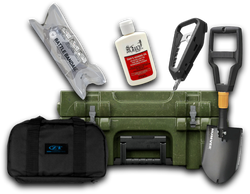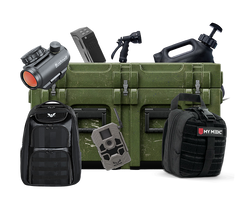What Came After the Musket: The Evolution of Firearms
Table of Contents
- Introduction
- The Musket: A Brief Overview
- Transition to Rifled Firearms
- The Repeating Firearms Revolution
- The Emergence of Automatic Firearms
- The Advent of Modern Firearms
- Modern Firearms: Tactical Gear and Preparedness
- Conclusion
- FAQ Section
Introduction
The musket, a staple in the arsenals of military forces from the 17th through the 19th century, was a revolutionary advancement in firearm technology. However, as with all technological advancements, it was not the end of the line. Have you ever wondered what came after the musket? The transition from muskets to modern firearms was not just about changing designs; it was about a fundamental shift in warfare, technology, and society. This blog post will take you on a journey through the evolution of firearms following the musket era, exploring the innovations and historical events that shaped the weapons we recognize today.
In this comprehensive overview, we will delve into key developments in firearm technology, including the introduction of rifling, the emergence of repeating firearms, and the advent of automatic weapons. We will also touch upon the socio-political factors that influenced these advancements, the impact of warfare on firearm design, and how each evolution played a role in the tactical landscape. By the end of this article, you will have a thorough understanding of what came after the musket, and how these advancements continue to resonate in modern tactical applications.
The Musket: A Brief Overview
Before we explore what came after the musket, it's essential to understand what made the musket significant. Muskets were smoothbore firearms, predominantly used from the 16th to the 19th centuries. They were characterized by their long barrels and the ability to fire a lead ball. The introduction of the flintlock mechanism in the 17th century marked a significant advancement, allowing for improved reliability and faster firing compared to earlier matchlock weapons.
Muskets were primarily used by infantry in battles, forming the backbone of armies around the world. They had a significant impact on military tactics, leading to the development of formations and strategies that relied heavily on massed fire. However, as the nature of warfare evolved, so too did the need for more advanced weaponry. Thus, the stage was set for the next generation of firearms.
Transition to Rifled Firearms
The Birth of Rifling
The first major leap forward after the musket was the introduction of rifled barrels. Rifling, the process of cutting spiral grooves inside a barrel, allows a projectile to spin as it travels down the barrel, greatly improving accuracy and range. Rifled firearms began to appear as early as the late 15th century, but they did not gain widespread use until the 18th century.
The rifled barrel’s ability to stabilize a projectile marked a significant shift in firearm technology. It enabled marksmen to engage targets at much greater distances with higher precision. This capability was instrumental in military conflicts, as it allowed soldiers to take advantage of cover and engage the enemy from a distance.
The Impact of the Rifle on Warfare
The introduction of rifled firearms changed the dynamics of battlefield tactics. As accuracy improved, military formations had to adapt to the new reality. Skirmishers and sharpshooters became essential components of military strategy, as they could pick off enemy soldiers from a distance. This evolution led to the decline of massed infantry charges, which had been the hallmark of musket warfare.
Key examples of rifled firearms include the American Civil War's Springfield Model 1861, which featured a rifled barrel and a minie ball—a conical bullet that further enhanced accuracy. The increased effectiveness of rifles during this conflict demonstrated the obsolescence of smoothbore muskets, paving the way for a new era in firearms.
The Repeating Firearms Revolution
Early Repeating Firearms
The next significant advancement in firearms came with the development of repeating firearms in the 19th century. These weapons allowed soldiers to fire multiple rounds without having to reload after each shot, fundamentally changing the pace and intensity of combat. The first successful repeating firearm was the Colt revolver, developed by Samuel Colt in 1836. This revolver utilized a rotating cylinder to hold multiple cartridges, enabling quick successive shots.
The Lever-Action and Breech-Loading Mechanisms
Following Colt's innovation, other manufacturers began to explore repeating designs. The lever-action rifle, such as the Henry rifle introduced in 1860, became popular for its ease of use and rapid reloading capabilities. These firearms allowed soldiers to maintain a high rate of fire, significantly increasing their lethality on the battlefield.
Simultaneously, breech-loading mechanisms began to gain traction. Instead of loading ammunition from the muzzle, soldiers could load cartridges from the breech, which was a much faster and safer process. The Spencer repeating carbine, adopted during the American Civil War, exemplified this innovation, allowing soldiers to fire multiple rounds quickly without the need for cumbersome muzzle-loading techniques.
The Impact on Military Tactics
The introduction of repeating firearms and breech-loading mechanisms forced military leaders to rethink their strategies and formations. With the ability to fire multiple shots in quick succession, the traditional tactics of massed infantry formations became increasingly vulnerable. This led to the development of trench warfare and more defensive strategies, particularly during World War I, as soldiers sought cover from the hail of bullets.
The Emergence of Automatic Firearms
The Birth of Machine Guns
The late 19th century saw the birth of automatic firearms, which further revolutionized warfare. Richard Gatling's invention of the Gatling gun in 1861 marked a significant milestone. This hand-cranked machine gun could fire multiple rounds rapidly, providing a devastating advantage in battle. Gatling guns were first used during the American Civil War and showcased the potential of automatic fire.
A more significant leap came with Hiram Maxim's invention of the Maxim gun in 1884, which was the first true automatic machine gun. Unlike the Gatling gun, the Maxim gun utilized the energy from the recoil of the fired bullet to cycle the action and load the next round. This innovation allowed for sustained fire without the need for manual operation, drastically increasing firepower on the battlefield.
Automatic Firearms and Their Tactical Implications
The introduction of machine guns changed the landscape of warfare entirely. The ability to lay down a continuous stream of fire made traditional offensive tactics highly perilous. Armies began to construct fortified positions and adopt strategies that emphasized cover and concealment. The advent of automatic firearms paved the way for modern warfare, as they became integral to both infantry and mounted units.
The Advent of Modern Firearms
The Transition to Smokeless Powder
The late 19th century also saw the transition from black powder to smokeless powder. This change offered several advantages, including a cleaner burn, increased velocity, and reduced smoke obscurity on the battlefield. As a result, firearms could achieve greater range and accuracy, further enhancing their effectiveness.
The Introduction of the Bolt-Action Rifle
The bolt-action rifle, epitomized by the Mauser Model 1898, became the standard infantry weapon by the early 20th century. The bolt-action mechanism allowed for quick reloading while maintaining accuracy and power. Bolt-action rifles dominated military arsenals during World War I and continued to be used for decades thereafter.
The Rise of Assault Rifles
As warfare evolved, so too did the demands on firearms. The development of the assault rifle, beginning with the German StG 44 during World War II, represented a paradigm shift in infantry firearms. The StG 44 combined the features of a rifle and machine gun, allowing soldiers to engage targets effectively at various ranges. This concept of a lightweight, selective-fire weapon became the foundation for modern military rifles.
Modern Firearms: Tactical Gear and Preparedness
The evolution of firearms has not only impacted military engagements but also influenced civilian applications. Today, tactical firearms are used by law enforcement, security personnel, and civilian enthusiasts. Brands like Crate Club have recognized the importance of quality tactical gear and offer curated subscriptions featuring premium firearms accessories, survival tools, and essential gear for those seeking to enhance their preparedness.
Crate Club Subscription Services
For those looking to bolster their tactical capabilities, Crate Club offers four subscription tiers designed to meet various needs and skill levels:
- Lieutenant Tier ($49.99/month): Ideal for casual or new tacticians, this tier includes survival tools, fire starters, and everyday carry (EDC) gear.
- Captain Tier ($99.99/month): For those seeking a comprehensive mix of survival and tactical gear, this subscription includes essentials like medical kits and EDC packs.
- Major Tier ($199.99/month): Tailored for experienced survivalists, this tier delivers premium gear that undergoes extensive testing, ensuring quality and reliability.
- General Tier ($399.99/quarterly): Featuring professional-grade tactical gear used by experts, this subscription offers high-end items like tactical flashlights and custom bulletproof inserts.
For more information about Crate Club's subscription services, check out Crate Club Subscription Services.
The Crate Club Shop
In addition to subscription services, Crate Club also features a shop where you can purchase individual tactical items and gear. This allows enthusiasts to find exactly what they need to enhance their preparedness, whether for outdoor adventures, personal safety, or simply to expand their collection. Explore the offerings at the Crate Club Shop.
Conclusion
The evolution of firearms following the musket era is a fascinating journey marked by innovation and adaptation to the changing landscape of warfare. From the introduction of rifling to the development of automatic firearms, each advancement has played a crucial role in shaping modern military tactics and civilian firearm applications.
As we reflect on this history, it is essential to recognize the ongoing evolution of firearms and the importance of preparedness in today's world. Whether you're a tactical enthusiast, a survivalist, or simply someone interested in firearms, understanding this evolution enhances your appreciation for the tools at your disposal.
By staying informed about the advancements and trends in firearm technology, you can make educated decisions about your gear, ensuring you are well-prepared for whatever challenges may come your way. Join the Crate Club community today, and equip yourself with the best tactical gear available.
FAQ Section
Q: What is the difference between a musket and a rifle?
A: A musket is typically a smoothbore firearm designed for mass military use, while a rifle has rifled barrels that improve accuracy and range. Rifles became more prevalent following the decline of the musket.
Q: How did the introduction of rifling change military tactics?
A: Rifling improved accuracy, allowing soldiers to engage targets from greater distances. This led to the development of skirmisher tactics and decreased reliance on massed infantry formations.
Q: What are the benefits of automatic firearms?
A: Automatic firearms allow for rapid successive firing without manual reloading, significantly increasing a soldier's firepower and altering traditional combat strategies.
Q: What is an assault rifle?
A: An assault rifle is a lightweight, select-fire weapon that combines features of both rifles and machine guns. It is designed for effective engagement at various ranges.
Q: How can I enhance my tactical preparedness?
A: Consider joining Crate Club for curated gear and subscriptions or explore their shop for individual tactical items. Staying informed and equipped is key to preparedness.
In summary, understanding the evolution of firearms from the musket to modern weaponry reveals the ongoing interplay between technology and warfare. Equip yourself with the knowledge and gear necessary to thrive in any situation.
Comparte este artículo



